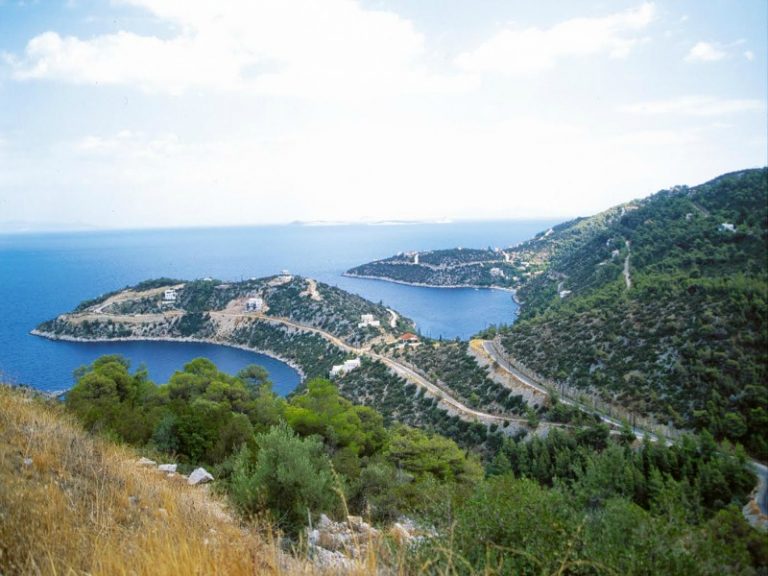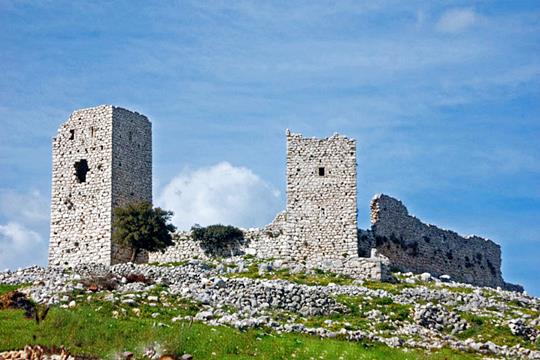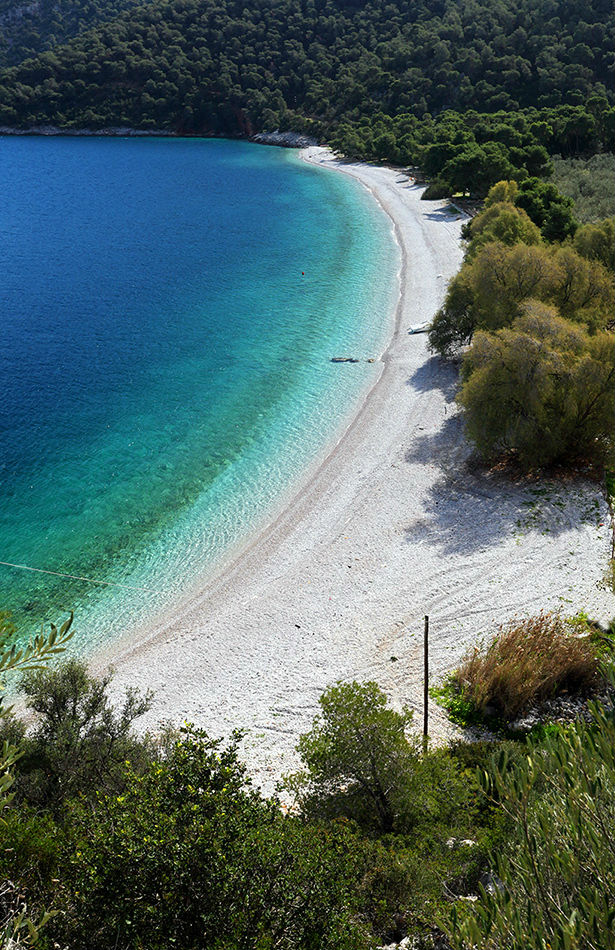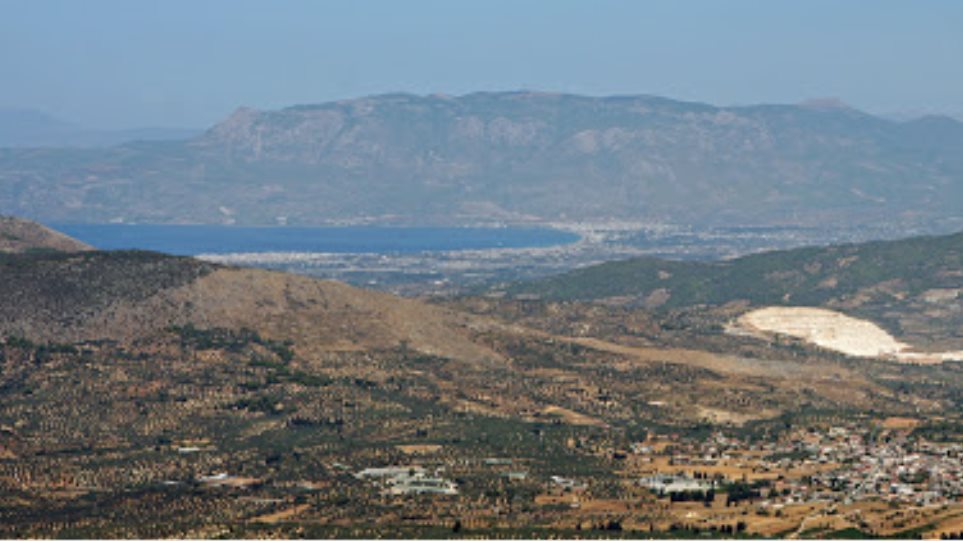
Soligeia: An unknown and hidden treasure in the Saronic Gulf, a breath away from Athens
Source: travelstyle.gr, Published: 24/3/2017
A short distance from Athens and the capital of Corinth is Soligeia, one of the most beautiful areas of the prefecture and the Peloponnese.
The Kapodistrian municipality of Soligeia (01-01-1999) includes the villages of Sofiko (2100 inhabitants), Angelokastro (300 inhabitants), Korfos (300 inhabitants).
It presents a great diversity of nature, since the Saronic Gulf forms deep blue and lacy beaches, many of which are suitable for swimming.
It is green especially with pines, several olive trees, vineyards and tobacco fields (Angelokastro).
The area has developed livestock, while olive oil and honey of excellent quality are produced.
In ancient times the name Soligeia had an area on the so-called Soligeio hill, near the present village of Galataki at a distance of 11 km from Sofiko. According to tradition, the name was derived from the composition of the words Solos, health. The great Athenian sage and legislator, at some point in his life, when he was ill, settled there and the good climate and the waters of the area helped to restore his health. It is mentioned for the first time in the history of Thucydides during the narration of events of the Peloponnesian War (431-404 BC), during which one of the fiercest battles took place in the region in September 425 BC. between the Athenians under General Nikias and the Corinthians under Vattos, who finally managed to repel them. During the second descent of the Dorians around 1104 BC, a stronghold was built by them on Soligeio hill, from where they started many excursions until they managed to occupy Ancient Corinth from the Aeolians, to overthrow the Sisyphus dynasty and to establish the hegemony of their leader Alitis. Soligeia as well as Corinth suffered complete destruction after the domination of Roman troops in 146 BC. by Lefkios Mommios.
Nikolaos Verdelis made important excavations in the area in 1957. He discovered the ruins of a temple that was probably built in 800 BC. and is said to have been dedicated to Demeter and her daughter Persephone. Near the temple was discovered a cemetery of chambered tombs of the Mycenaean period (1450-1400 BC), the remains of which are still visible today near the church of Prophet Elias. In the vicinity of these tombs were found ceramic vessels, navel bottles, compasses, figurines. Some of them are now on display at the Museum of Ancient Corinth.
During the years after the liberation with the B.D. 3-4-1833 the Municipalities of Soligeia were formed (1529 inhabitants) with headquarters in Sofiko (first Mayor of A. Nordas) which included Korfos and Yrnithi (194 inhabitants) with headquarters in Angelokastro (first Mayor Vassilios Irini). Later with .Δ. 27-11-1840 the Municipalities of Yrnithi, Rytos and part of the Municipality of Apia were merged in the Municipality of Soligeia.
The Municipality of Soligeia with the B.D.31-08-1912 was abolished and divided into Communities and Settlements.
It was reconstructed on 1-1-1999 (Kapodistrias Law) and included Sofiko (headquarters), Korfo and Angelokastro.
With the Law of Kallikrates from 01-01-2011, this Municipality was merged in Corinth.
The villages of Soligeia have an important history and many attractions.
Sofiko (410 m. Altitude)
Located on the hill of Tzalikas (780 m. Altitude)
There are testimonies that in its place during the classical era there was the settlement of Pigi, which was preserved until the 10th century AD. It was rebuilt in the 14th AD. century.
The Sofikite lieutenant-general Ioannis Hatzis Mertzellos (1791-1860), who prepared the revolution in Sofikos, has a great role in the Greek Revolution, since all the chiefs who took part in the siege of Acrocorinth (01-04) were sworn in. On 30-03-1821 the Bishop of Damalon, Jonas, arrives here and together with Mertzelos, they proclaim the Revolution in Corinth. By decision of the Executive Body on 14-07-1823, it becomes the seat of the Revolutionary Government that remained until 16-08-1823 when it was transferred to Salamina. In the summer of 1826 it becomes a theater of civil battles of the Notaries (Ioannis vs. Panagiotis).
During the Greek-Italian War, the action of the distinguished Sophistic Captain Miltiadis Iatridis (1906-1960) is great. As captain of the submarine “Papanikolis” he acted especially in the Adriatic and managed to sink 3 Italian barges in the Straits of Otranto. saboteurs, causing damage to the Axis ships. With the end of the war (1941) he led his submarine to the Middle East.
Inside the village there are many houses of traditional architecture, while throughout the area it is worth visiting the historic church of Agios Georgios. It is a stone-built, historic church, dating from 1700 in the style of a single-aisled cruciform basilica with a dome. It has important murals and was restored in 2016 with an EU program.
Right next to it, Agios Charalambos was built at the beginning of the 19th century.
At the eastern end there is a church dedicated to Agios Nikolaos, Demetrios. It was built in 1780 in the style of an arched basilica with frescoes inspired by the daily life of the Sophics of the 18th century.
Annunciation of the Virgin
It was built in the center of the village (Kokkinia district) in 1842. It is made of stone of royal style, single-aisled. The iconostasis dates from 1847. There is a hagiography of Agios Eleftherios, work of the Cretan Nikolaos Vasilakis. It has been renovated in 2001.
Monastery of the Assumption of the Virgin – Hodegetria 320 (m. Altitude)
It is located at a distance of 3 km from the village, very close to E.O. Isthmia – Epidaurus.
The professor of Byzantine Archeology Anastasios Orlandos, who visited the area in 1933, considers that the current katholikon of the Monastery was built in the 12th century and that it was built on a pre-existing early Christian church. For its construction, materials from a large ancient Greek temple of Aphrodite were used, some of which we see today scattered in the courtyard of the Monastery.
It is a Byzantine cross-roof with a dome.
The frescoes date from the 12th century to 1558. The iconostasis was made in 1801. An important heirloom is the Holy Icon of the Most Holy Theotokos Hodegetria.
At a distance of 150m is the Church of Agia Paraskevi, dating from 1617, belonging to the Cemetery of the Monastery, with a iconostasis painted in 1737, while important is a mural depicting the dance of the young.
Temple of Taxiarches
It is located 4 km from the village in Larissi.
It dates from the end of the 12th century in the style of a Byzantine cross-roof with a dome.
Nearby is the Church of the Holy Trinity, early 13th century, Byzantine cross-roof with great archeological frescoes.
On the shores of Sofiko there are beautiful coves such as Amonios Kalogerolimano, Frangolimano overgrown with pines and beaches suitable for swimming.
A real jewel for Sofiko is the ranch at Laka Bekatun (600m. Altitude) on Tzalika hill at a distance of 700m. from the village. There is a children’s camp with a theme park, while there are many events.
Several taverns offer fine specialties. The archeological rhythm theater organizes many cultural events, especially the summer, theatrical music, dance.
Unique in Corinth is the custom of Yem on the three days of Easter with dances and songs.
Korfos, the Riviera of Soligeia
We take the road east of Sofikos and through a dreamy route of 8 km, where the pine dominates, we end up in this beautiful seaside village at the mouth of the bay.
The environment and the climate are wonderful, the shores are ideal for swimming, while in the numerous fish taverns one can taste the local seafood specialties.
An uphill but good road at a distance of 4 km north of the village, leads to the historic chapel of Panagia tou Steririou in the homonymous location.
It was built in the second half of the 11th century. He is associated with Saint Luke Steritis, founder of a monastery in Boeotia who stayed in Corinth during the years 918-928 and practiced here.
It is a type of cruciform dome. The Byzantine sculptural decoration is limited to the marble iconostasis. On the floor of the sanctuary, a large part of it is preserved from colorful pieces of marble with which it was once completely paved.
Remarkable murals of 1668 are the work of the great Nafplio hieromonk, hagiographer Theodoulos Kakava.
In the surrounding area, medieval building remains can be seen that show that the Temple was a catholic monastery. The two-storey Byzantine building north of the Temple is the best preserved.
At a distance of 1.5 west of the area there is the chapel of Agia Anna. It was built in 1774 and was the katholikon of the Monastery, the other buildings of which, as monks’ cells, are now in ruins.
At a distance of 3.5 km east, the road leads to Kalamiano, where in 2001 the ruins of a residential complex, a remarkable port in the Mycenaean period, were found. The locals call it “the port of Agamemnon”.
It is believed that it flourished in the 13th century BC.
Further south, a road leads to the bay of Selontas with a sandy beach, which served as a refuge for “Papanikolis” against World War II.
In Korfos there are many hotels, rooms for rent, while many holiday homes of Greeks and foreigners have been built.
Angelokastro
Picturesque mountain village on the hill of Poulageza, at an altitude of 740m. It is 8 km from Sofiko. In the ancient Greek period in its area it is speculated that there was the settlement of Yrnithio.
It flourished during the Byzantine years. It took its name, probably from the “castle of ads” that exists in the village and from which they were transported by torch messages to other areas. It was built in the 12th century by the Byzantine emperor Angelos Komnenos. Today it occupies an area of 4 acres. It consists of a citadel with a tower – observatory and a courtyard of towers and huts, while outside the courtyard there are ruins of Roman houses.
During the Revolution of the 21st century, the action of the Angelokastriti thousandaire Vassilios Irini, later Mayor, who fought under the Nikitaras, Gennaios Kolokotronis with great participation in the battle of Dervenaki (26-07-1822) was great.
At a distance of 2 km south of the village at Patima, the road that continues to Arachneo, leads us to the ruins of an ancient building that legend considers to have been the palace of Princess Yrnithos.
In an area inside the new church of Agios Dimitrios (1997), there is an Ecclesiastical-Folklore Museum, with valuable objects, including wall-mounted frescoes of the Church of Agios Nikolaos.
Next door is the old church that was renamed in honor of Agios Ioannis Prodromos. It dates from the middle of the 19th century, a stone basilica with an elevated square vaulted dome.
In the center of the village there is the oldest church of Agios Nikolaos, dating from the 10th century, declared a protected area.
It is a stone-built tiled roof in the style of a single-aisled basilica with magnificent Byzantine art frescoes.
In this Temple were found, among others, and transferred to the local Museum:
Gospel published by Venice 1761
– 12 Gospels published by Venice 1876
-expert of publication 1631
There is a tavern that offers delicious local livestock products.
Very close to Sofiko (12 km) within the Prefecture of Argolida on the National Road is the historic Monastery of Panagia Agnouta.
The area can be a base for excursions to many interesting neighboring locations such as Epidaurus, Nafplio, Mycenae, Arch. Corinth, Loutraki.
Come to the beautiful Soligeia. You will be impressed by the green landscape, the deep blue beaches, the monuments, the hospitality of the inhabitants!





